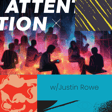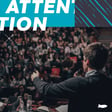Introduction and Purpose
00:00:02
Speaker
Welcome back to The Attention Podcast, where you'll learn how to gain and retain the attention of your buyers to build an
Interview with Ryan Baker
00:00:07
Speaker
audience. I'm Dan Sanchez, and today I talked to Ryan Baker, who had a fantastic little case study about how to build a proper lead magnet in order to grow MQLs for your business that could also be used to grow an audience.
Lead Magnets in B2B
00:00:20
Speaker
So in this interview, I wanted to highlight the fact that he's using something that a lot of B2B companies ignore in taking a piece of his process as a consultant.
00:00:29
Speaker
and then putting it out there to solve the problems of his ideal buyers. So I think you can take a look at this, look at your own processes and see what you can do in order to build lead magnets that freaking work to grow your company. Take a listen and steal this idea.
Successful Case Study
00:00:52
Speaker
Brian, so you have a story to tell about Lead Madness. Tell us what it was that worked so well for you when it comes to Lead Madness. Yeah, so I had this idea for a service that I wanted to provide, kind of a new consulting framework, and I wanted it to be centered around helping people design and optimize processes to increase client experience and the marketing agency, that sort of thing.
00:01:16
Speaker
But I didn't want to put in a ton of work building this out. And so instead of just like running ads with the IDX, I didn't know how to do that really, I put together this this fully done for you spreadsheet, client onboarding process, like one of the most important processes you can have in a marketing agency.
00:01:34
Speaker
And I put it together in a spreadsheet. I included the top three project management software upload templates in the same spreadsheet. And then I included a little bonus thing for people onboarding Google Ads clients. And I dropped it to my LinkedIn community, which I have roughly 5,000 people. It's not massive. But I was like, OK, this will be a decent enough sample size to get a feel for how well this service would be received.
Client Engagement and Service Expansion
00:02:03
Speaker
And it like instantly became my top post, had tons of engagement, everybody, like at any given time, there were like nine or 10 people on the spreadsheet. So, you know, it's a Google Sheet, you see all the anonymous people on there.
00:02:19
Speaker
And it was getting a lot of feedback. I got lots of actual people reaching out to me wanting to work with me, which had never happened on LinkedIn for me before, so that was cool. Consistently getting people coming to my website and filling out forms just because of this. And I consistently get more people in my network, like the right people on LinkedIn asking to connect with me because of this post.
00:02:45
Speaker
Hey, I have affirmation that yes, this is the path I want to go with. So I'm putting in the work now to build out the service, but I also am getting leads like before having built it all out so I can develop those relationships over time and turn it into revenue. So worked really well. So lots of questions. First, how did you like.
00:03:05
Speaker
how did you discover this was the thing to even create a lead magnet for?
Consulting Background and Need
00:03:09
Speaker
Like what was the problem? Were you getting lots of feedback from people being like, we suck it on board and we suck it on board and we need help. How did you, or do you just know it from experience that it was hard and you just took something you already had to make it? Like where was it on that?
00:03:21
Speaker
Yeah, so I've consulted with marketing agencies over the last eight years in various different ways. I've consulted with them, I've coached their ad managers, I've worked in them as like VP or director of client services, all sorts of different roles. And so my experience in the agencies is that a lot of them don't have the processes, don't have the processes well dialed, and there's not a lot of adoption of those processes.
00:03:46
Speaker
If they do have the processes, a lot of times it's because like, they've just copy pasted it from somebody or they've just kind of like documented what they're doing. So they don't necessarily know how to improve that if they're not being intentional about it, which a lot of them don't have time to be intentional about it because it's just like chaos. So I thought, okay, I just come off of the the hormones like, you know, $100 million leads
Free Information Strategy
00:04:08
Speaker
book launch and everything. And it was like, yeah,
00:04:09
Speaker
You know, I have kind of like these lead magnet ideas, but let me just give all of the stuff away for free, all the information away for free, and then charge to implement. And so, you know, give them a taste of what I can do, solve one problem, and then
00:04:25
Speaker
You know if they want more they can pay me for more and it seems to have worked well for that so on boarding is one of those things that like sets retention from the get go it really influences how long you can keep someone so i figure if i solve that problem for them they can have better client experience right off the get go.
00:04:45
Speaker
and then move forward with this desire for more processes and better processes and find out, okay, how else can you help me increase client experience, client retention, and then even rates? Because perceived value on the forefront really affects how happy somebody is paying you a higher rate.
Social Media Exposure
00:05:04
Speaker
So that's a good insight because I mean, I used to work for an agency and I knew like onboarding was always the struggle. Everybody would say like, man, your sales process was so awesome. Right. And then what happened? Seems like the wheels fell off the bus somewhere in the implementation process. Right. Oh, such. And I know it's a struggle for most agencies.
00:05:25
Speaker
And, but I think the real insight is like, if you're already working, the key is like, are you working with your clients enough to know what the problem is, right? You were a consultant, you knew the problem was onboarding because you, that's how you knew. You were talking to them, working through them with it all the time. And so you just found your process and documented it. Did you just, did you already have like a template already and just put that out or did you make any changes to it?
00:05:51
Speaker
So I had like templates generally in my consulting, I would custom make something for a an agency I'm working with. But I thought, you know, as part of the idea that I had of building out this service, I wanted to build a living process library that was always growing, always getting new processes, I thought of or spotted a new process.
00:06:10
Speaker
And then just have that available to my consulting clients moving forward. Say, OK, you want to work with me. You're paying me a lot. Here's a ridiculous amount of value. Now I'll help you implement this and train your team on adoption and things like that. But I thought, I don't want to do all the work to build all that out if it's not going to be valuable. Let's see how they respond to just getting a done for you process. Because a lot of people have onboarding processes, or at least a way that they onboard people that they try to follow consistently.
00:06:37
Speaker
And it seems to have hit the nail on the head. So I knew that customer understanding is really important, but it still doesn't hurt to test hypotheses. And so why not do it with a lead magnet? Provide that value and see if you can't get some revenue in the door and then build it out further. So once you kind of tested it, send it to a few people you knew, and they were giving you really good feedback on it, what did you do with it afterwards? Did you post it on social? Did you put some paid media behind it? Where did you go
Prioritizing Relationships over Lists
00:07:07
Speaker
Yeah, so it is the forefront post, featured post on my LinkedIn profile. I've also added it to a Facebook group so I can add agency owners there. And in addition to having the done for you process built out, we can also kind of get in front of them more consistently with like exclusive content or a like the odd coaching call where I kind of walk them through why each piece of this or other processes works and what does, what doesn't.
00:07:35
Speaker
So with this kind of lead magnet, you're putting it out there as a featured post. Do you send people to a landing page to opt into it? So that was one interesting thing about this. I had the option to use it as a list building tool, and I will probably do that in the future. For now, I just want to gain as much exposure and association to solving this problem as possible. So I've made it ungated, and all people have to do is go to my LinkedIn profile.
00:08:05
Speaker
get on the post, download the spreadsheet or make a copy, use it for themselves, get that value. I do, at the top of the post, have a walkthrough guide at the end. I've got a little call to action. I've got my email address there. So people have ways of reaching out to me after going through this. But for now, it's just give as much as possible, gain exposure, build a following. And then as I have influence, I'm building a newsletter. I'm getting a lot of traction from that. And I'll be able to build a list further.
Format Choices and Accessibility
00:08:34
Speaker
some paid ads and they, you know, a landing page for it. Man, I am not on team gated or I'm not on team ungated. I like to gate these things to build my email list. I'm surprised you're just giving it away. I'm like, I'll be putting more hooks in there because it's such a it maps so well to what you do already.
00:08:53
Speaker
I do have a, I have my fifth kid on the way at the end of this month, and so I've got a little time that I'd like to be a little slower, and then I can put a little paid ads behind this, a little bit of a gate and get some people in my list to then further ramp up. That's fair, that's fair. Gate that mug, get some, at least some email newsletter subscribers from it, and then of course it probably translates really well into like paid, or paid gigs for you too.
00:09:23
Speaker
And you're delivering it via Google Sheets. Yeah, specifically. Yeah. Google Sheets. And there are template uploads for like Asana, teamwork.com, Monday.com. And it is easy to use as a standalone checklist or as one of those to upload into task lists for those platforms. Yeah. Any reason for Google Sheets specifically versus Excel or something else?
00:09:45
Speaker
Well, with Google Sheets, I can see when people are on it. And I can also sometimes people reach out and request access to edit it. And I can say no, but then I also have their email address. So that's one way of, you
Generalizing Templates
00:09:58
Speaker
know, gating it for the odd person, but to share your access.
00:10:02
Speaker
My my main lead magnet is on Google sheets, but I put it there just because I didn't know where else to put it It's like yeah, I don't know. Where do I put this? Everyone's on Google right or for the most part not everybody has Excel Not everybody has numbers, but I don't know where else I wish it was just like a standalone like
00:10:18
Speaker
thing, but then I'd have to code it. A simple checklist, you just can't put that on a website unless it's a downloadable PDF, but you want it to be somewhat interactive. You fill it in like a worksheet, so I ended up with a Google Sheet too. I didn't even think about, oh, I can see who's viewed this thing from that, and I haven't even looked at the analytics for it. There are pros and cons, yeah.
00:10:40
Speaker
Let's break down a little bit more how you reverse engineered what you already had. How did you, did you go back through and just like create a new template and then just start generalizing it to fit more agencies? Like how did you, what was your process for turning it into a better general lead magnet?
00:10:58
Speaker
Yeah, so I definitely I did start with a much more general focus. And this is one thing I've identified with some of the data I've collected is that over time, because my experience is largely tied to helping agencies with PPC services and search engine marketing services.
00:11:14
Speaker
I'll probably niche down into that first. I'm not going to be able to, you know, I'm not going to turn away agencies that don't offer PPC services if I can help them in a really high quality way, but I want to make sure I'm focusing on where I can provide this value.
00:11:29
Speaker
So with a more general client onboarding process, you don't necessarily have to include any of the service specific tasks. So I just focus on, okay, what are the overarching steps that need to happen to get somebody from signing an agreement to sending them the invoice, which generally happens before the service is done in an agency.
00:11:54
Speaker
And then going through like, okay, send it to the teams, educate the teams on what's been discussed so far, like, okay, what are all these steps? And then break down, you know, each of the little steps that needs to, you know, be the bridge between the major steps.
00:12:09
Speaker
So you kind of have those, you know, big rocks, little rocks, if you will. And then I wanted to also explain like reasons behind everything and tie those reasons to client experience. So I was one of the first 1000 customer experience like
00:12:25
Speaker
certified customer experience professionals in the world. I have a big passion for this. I don't want to do CX work in the traditional sense, but I do want to make sure that CX is a focus of everything that I do in my consulting because I do think it has an impact on revenue and on retention.
00:12:47
Speaker
So I wanted to make sure that every step not only helps the team that's doing the work, but also helps the client. So it's kind of a heavy focus on the relationship and communication, heavy communication on the front with the client and then also with the team. So like sales is communicating with the client facing team.
00:13:09
Speaker
I also built out documents for like, hey, here's a questionnaire that you can deliver. Here is a checklist that you can make sure that you're going through, and here is a document to make sure that you're asking for all of the right access, and here is something you can send them to show them how to agree to things. Try to give as much as possible to just make sure that, hey, you can take this, run with it, and get a better experience right off the bat.
Short vs Long Engagement
00:13:36
Speaker
So this is something that I've been learning a lot, and I think you're doing this right. But where I think most B2B marketers go wrong with lead magnets is they're just too long. They're hard to consume. The state of the industry reports, an e-book, even a well-written, well-designed guide just takes too long to consume. If you have to sit down, if you read it word for word in order to get the content, it takes 15 minutes, too long.
00:13:59
Speaker
So what I'm really falling in love with is the idea of leading with a checklist, a template, a worksheet that you can get value from within 30 seconds of glancing at it. And you build in pieces, breadcrumbs that lead to more content that they want more explanation on this part or this question or this section because now they're starting to consume. You create like a rabbit trail or a breadcrumb trail from
00:14:28
Speaker
solving an immediate problem within 30 seconds to spending maybe 5, 10, 15 minutes of consuming it, but you make sure they're getting value from it no matter where that drop-off point is, which I think is the real trick, though, I think what we're starting to unlock with lead magnets.
00:14:43
Speaker
Yeah, I think if you think of it like a YouTube video, right? You know, generally people see the thumbnail and they click on it. And, you know, sometimes they read the title, but generally the thumbnail gets the attention. They click on it and you generally want to keep them for 30 seconds, as many people as possible. But you have maybe three to five seconds for them to decide to keep watching. And every little section has to keep people watching for the next section.
00:15:12
Speaker
And so your goal with a lead magnet should be, okay, how can they immediately perceive value? I mean, like lead magnet landing page, fill in the blank. How can they immediately perceive value? And then how can they see that value continue to increase and expand as they get deeper and deeper into it? And that I think is kind of what generates the demand. So initially they have interest and then as they see the value you can provide for them, they have kind of more demand for more value.
00:15:42
Speaker
And if the whole thing just kind of guides them through to deeper and deeper value and practical application, then they know, OK, this person can help me solve more problems because they've already helped me solve this initial problem or they've already helped me get this type of outcome. It's kind of like what Joe Sugarman talks about with copywriting, right? The goal of the picture is to get them to read the headline. The goal of the headline is to read the first sentence. The goal of the first sentence
00:16:09
Speaker
the second sentence, right? So we try to create a slippery slope with a lead magnet, but instead of just teasing value, like they do in YouTube videos often, they'll like tease a little bit, they're actually, you're giving value right away so that they can unlock it and it becomes a slippery slope of value as they, you're selling them on consuming more because they're getting, they can get value in 30 seconds, they'll get even more value and they spend three minutes, 10 minutes actually unpacking it.
00:16:35
Speaker
So I think that's, that's the trick and the unlock that I'm starting to get now that I'm diving more
Solving Client Problems Continuously
00:16:39
Speaker
into this topic. Cause I, like you read Alex Hermosi's book and now I'm like, Oh my gosh, I got to figure out how to do this better. I was, I was playing in the JV league and I need to get up to Olympic league fast on lead magnets. Cause this is clearly where it's at.
00:16:52
Speaker
Yeah, I do like that idea of solve a problem and show them that you have the capability of solving more of their problems. Really, I've heard it said that if you solve a problem, it creates other problems. There's the emergent properties. If you have to walk everywhere, you want to buy a car. Well, you buy a car, that creates more problems. You got to get gas, you've got to get car insurance, you have to learn how to drive safely, which is not always easy in some places.
00:17:18
Speaker
And you end up with all these other problems. Well, there are people to solve all those problems for you. You've got mechanics, and you've got gas stations, and you've got insurance companies. So if you can be the one that solves the problems that are created by the initial problem you solve, then you can retain a customer longer, increase your lifetime value, and just get more referrals and more clients, more customers.
Conclusion and Call to Action
00:17:44
Speaker
This has been awesome, Ryan. Ryan, can I get a link to this lead magnet to drop in the show notes in case people want to check it out and take a look themselves? Yes, you can. Awesome. I will link to this in the show notes. Please take a look at it. Take notes. Go through your own processes and figure out what you have available that you might be able to split off as a first little step for them in their process to figuring out the whole problem. What small problem can you solve in the beginning? Just because you have processes, you might just
00:18:12
Speaker
like make it more general and add some content to it, but keep it short and simple like a template or a lead magnet or a checklist or something, put it on the front end for them to download to get value from, and then you become the obvious next two, three, four steps in the process. So take a look at Ryan's, see what you can learn from looking at his and reverse engineer it. If you're an agency, then it's going to be really helpful to you because it's a whole onboarding process. And we all know that most agencies struggle with this. So Ryan might be your guy for help with that.
00:18:42
Speaker
Ryan, thank you so much for joining me on the show. It's been fun. Thanks.

















